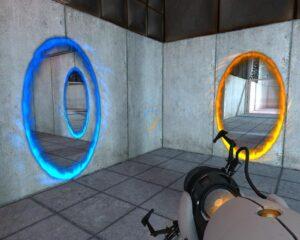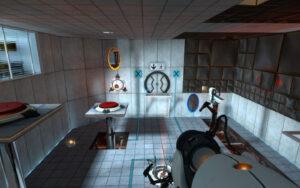
I recently replayed Portal, a puzzle-platform video game developed by Valve Corporation, through Steam. Portal is a blend of action, puzzle-solving, and environmental storytelling. The core mechanic of Portal is the use of a handheld “portal gun”, which allows the player to create two distinct portals on certain surfaces within the game’s environment. Each portal is a gateway that connects to the other, regardless of the distance or the orientation between them. If a player steps into one portal, they instantly come out of the other, maintaining their momentum. The portals can also interact with other game elements. For example, objects can be moved through portals, and energy projectiles can be redirected, adding layers of complexity to the game’s puzzles.

The beauty of this mechanic lies in its simplicity and the multitude of possibilities it presents to the player. It encourages creative problem-solving, spatial reasoning, and an understanding of the game’s physics to navigate through the test chambers.

The game presents each level, or test chamber, as a complex, three-dimensional puzzle box, where the solution is often non-linear. This leads to highly satisfying “Eureka!” moments when the solution to a puzzle suddenly clicks into place. Each test chamber, is carefully designed to introduce and gradually escalate the complexity of the portal mechanic, while subtly revealing the game’s backstory. The initial levels are simple, serving as tutorials to familiarize players with the concept of portals and basic mechanics such as moving objects or ‘flinging’ using momentum. The chambers are stark, sterile, and enclosed, emphasizing the feeling of being a test subject in a controlled environment. As the game progresses, the test chambers become increasingly complex, introducing new elements like energy balls, deadly liquid, mobile platforms, and turret enemies. The puzzles become multi-layered, often requiring the player to use multiple mechanics in conjunction to reach the exit. The environment also starts showing signs of decay and disarray, reflecting the narrative’s unfolding mystery. The game’s antagonist, GLaDOS, uses the promise of more complex puzzles as a form of manipulation, creating a strange but effective loop that ties directly into the game’s narrative arc.
The portal gun also adds to the chilling and mysterious atmosphere of the game by creating a sense of isolation. Players can only interact with the world through their portal gun; there are no other characters to communicate with or objects to manipulate. I felt like I was a test subject in a large, uncaring scientific apparatus. Hence, the single portal gun mechanic is able to weave together game mechanics, narrative, and environment to create an immersive experience.



